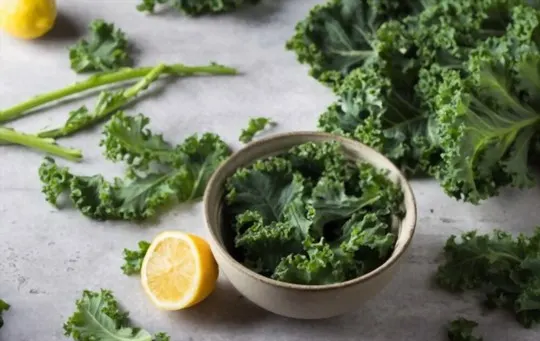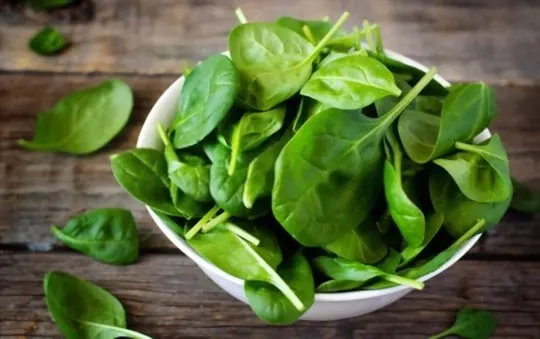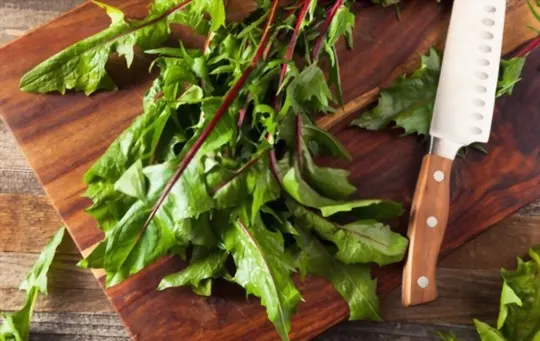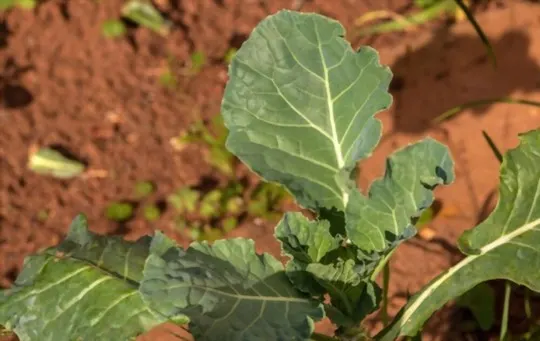Mustard greens pack a punch in any dish they grace.
Sometimes you’ve gotta improvise in the kitchen.
Finding a perfect substitute isn’t always easy.
Kale’s too tough, spinach wilts too fast, and what even is chard?
We’ve all been there, raiding the fridge for something green to throw into tonight’s dinner.
That’s where we come in. You need alternatives, and we’ve got the rundown on the top five substitutes for mustard greens.
Each of these greens brings its own flavor and texture to the table.
No need to stress if the grocery store’s out of mustard greens again.
We’re here to help you keep your meals vibrant and full of life, even when your first choice is MIA.
What are Mustard Greens?

For those who love to cook and experiment with new ingredients, mustard greens are a must-have in the kitchen.
These greens have a sharp, peppery flavor that can add a kick to any dish.
They are also packed with nutrients, making them a healthy addition to any meal.
Mustard greens are a leafy green vegetable that belongs to the Brassica family.
This family also includes broccoli, Brussels sprouts, and cabbage.
Mustard greens can be enjoyed cooked or raw, and they are often used in salads and stir-fries.
When raw, mustard greens have a slightly bitter taste and a crisp texture.
They are often used in salads or as a garnish.
Once cooked, mustard greens have a more mellow flavor and a softer texture.
They can be enjoyed as a side dish or added to soups and stews.
The 5 Best Substitutes for Mustard Greens
Mustard greens, known for their pungent flavor and peppery kick, are a popular leafy green used in various recipes.
However, if you don’t have access to mustard greens or prefer a milder alternative, there are several substitutes available.
In this guide, we will compare the top 5 substitutes for mustard greens, discussing their key characteristics and suggesting proper ratios to help you find suitable alternatives.
| Substitute | Key Characteristics | Proper Ratio |
|---|---|---|
| Turnip Greens | Earthy and slightly bitter flavor; tender leaves and stems; similar texture to mustard greens | Use an equal amount of turnip greens as a substitute for mustard greens |
| Kale | Slightly bitter and earthy flavor; sturdy and chewy leaves; holds up well in cooking | Use an equal amount of kale as a substitute for mustard greens |
| Spinach | Mild and slightly sweet flavor; tender and delicate leaves; quick-cooking and versatile | Use an equal amount of spinach as a substitute for mustard greens |
| Dandelion Greens | Bitter and slightly tangy flavor; tender leaves with a hint of sweetness; commonly used in salads | Use an equal amount of dandelion greens as a substitute for mustard greens |
| Collard Greens | Mild and slightly sweet flavor; sturdy and chewy leaves; similar texture to mustard greens | Use an equal amount of collard greens as a substitute for mustard greens |
Now, let’s dive into each substitute in more detail:
1. Turnip Greens

Turnip greens are a type of leafy green vegetable that is closely related to cabbage and kale.
The leaves are dark green and have a slightly peppery flavor.
Turnip greens are a good source of vitamins A, C, and K and calcium and iron.
They can be eaten cooked or raw and are often used in soups and stews.
Turnip greens are also a popular Southern dish, often cooked with bacon or ham.
Turnip greens are a good substitute if you can’t find mustard greens at your local grocery store.
They have a similar flavor and texture and can be used similarly to mustard greens.
When cooking turnip greens, remove the tough stems before cooking.
- Key Characteristics: Turnip greens offer an earthy and slightly bitter flavor with tender leaves and stems. They have a similar texture to mustard greens, making them a suitable substitute.
- Proper Ratio: Use an equal amount of turnip greens as a substitute for mustard greens. Adjust the cooking time as necessary since turnip greens may require less time to wilt.
2. Kale

When it comes to leafy greens, kale is in a class all its own.
This nutrient-packed powerhouse is not only low in calories and fat, but it’s also packed with vitamins, minerals, and antioxidants.
Studies have shown that kale can help to lower cholesterol levels, reduce the risk of certain cancers, and protect against heart disease.
And that’s just the beginning.
Kale is also a great source of fiber, which helps to keep you feeling full and aids in digestion.
Plus, it’s super versatile and can be enjoyed in various ways.
Kale can have a slightly sweet or nutty flavor, depending on the variety.
The texture is tender yet firm, perfect for sautéing, steaming, or baking.
So if you’re looking for a mustard green substitute that is nutrient-rich and packed with flavor, kale is a great option.
- Key Characteristics: Kale has a slightly bitter and earthy flavor with sturdy and chewy leaves. It holds up well in cooking methods such as sautéing, braising, or adding to soups and stews.
- Proper Ratio: Use an equal amount of kale as a substitute for mustard greens. Consider removing any tough stems before cooking, as they can be fibrous.
3. Spinach

Popeye was onto something when he discovered the power of spinach.
This leafy green is not only packed with nutrients, but it also has several health benefits.
For example, spinach is an excellent source of iron, essential for carrying oxygen to the cells.
It is also rich in vitamins A, C, and K and folate and beta-carotene.
When it comes to flavor, spinach has a milder taste than mustard greens.
However, it still has a slightly bitter flavor that some people may not enjoy.
As for texture, spinach leaves are much softer than mustard greens.
This makes them easier to chew and digest.
Ensure to wash spinach thoroughly before eating, as it can often be sandy or gritty.
To cook spinach, sauté it in a pan with oil for a few minutes.
You can also add it to soups, stews, or pasta dishes.
- Key Characteristics: Spinach has a mild and slightly sweet flavor with tender and delicate leaves. It is quick-cooking and versatile, making it an excellent substitute for mustard greens in various recipes.
- Proper Ratio: Use an equal amount of spinach as a substitute for mustard greens. Keep in mind that spinach cooks down significantly, so you may need more than the initial volume.
4. Dandelion Greens

There’s more to dandelions than meets the eye.
Those pesky weeds that dot your lawn may not look like much, but dandelion greens are a nutrient-rich food source.
They’re high in Vitamin A and Vitamin C and contain iron, potassium, and calcium.
Dandelion greens can be enjoyed cooked or raw, and they make a great addition to salads, soups, and stir-fries.
While dandelion greens have a slightly bitter taste, they’re still quite flavorful.
Their bitterness is mellowed out when cooked, and they take on a nutty flavor.
If you’re not a fan of bitter foods, you can blanch the greens before cooking to help reduce their bitterness.
Compared to mustard greens, dandelion greens are milder in flavor.
They’re also more tender, making them easier to eat.
- Key Characteristics: Dandelion greens have a bitter and slightly tangy flavor with tender leaves that offer a hint of sweetness. They are commonly used in salads and can provide a unique twist as a substitute for mustard greens.
- Proper Ratio: Use an equal amount of dandelion greens as a substitute for mustard greens. Consider blanching or sautéing them to mellow the bitter taste.
5. Collard Greens

Collard greens are a delicious and nutritious leafy green vegetable often grown in southern regions of the United States.
The large, dark green leaves have a slightly bitter taste that is often offset by adding bacon or ham when cooking.
Collard greens are an excellent source of vitamins A, C, and K and calcium and iron.
They are typically cooked by boiling or steaming and can be added to soups, stews, and casseroles.
When you run out of mustard greens, collard greens are a great substitute.
In terms of flavor, collard greens are slightly more bitter than mustard greens.
They also have a tougher texture, so that they may require longer cooking times.
However, their nutrient profile is very similar to mustard greens, making them a healthy and delicious option.
- Key Characteristics: Collard greens have a mild and slightly sweet flavor with sturdy and chewy leaves. They share a similar texture with mustard greens, making them an excellent substitute in cooked dishes.
- Proper Ratio: Use an equal amount of collard greens as a substitute for mustard greens. Adjust the cooking time as needed, as collard greens may require longer cooking to soften.
Conclusion
While mustard greens are a delicious and nutritious addition to any meal, they can be tough to find in some parts of the country.
If you can’t find mustard greens at your local grocery store, don’t worry.
There are plenty of other leafy greens that make great substitutes.
Here are five of the best: collard greens, kale, turnip greens, dandelion greens, and spinach.
These leafy greens have a similar texture and flavor to mustard greens, making them perfect substitutes in recipes.
So if you can’t find mustard greens, don’t hesitate to try one of these tasty alternatives.

The 5 Best Substitutes for Mustard Greens
Ingredients
- Turnip Greens
- Kale
- Spinach
- Dandelion Greens
- Collard Greens
Instructions
- Pick your favorite substitute from the list above.
- Follow cooking directions for your selected substitute with the proper ratio of ingredients.

Andrew Gray is a seasoned food writer and blogger with a wealth of experience in the restaurant and catering industries. With a passion for all things delicious, Andrew has honed his culinary expertise through his work as a personal chef and caterer.
His love for food led him to venture into food writing, where he has contributed to various online publications, sharing his knowledge and insights on the culinary world. As the proud owner of AmericasRestaurant.com, Andrew covers a wide range of topics, including recipes, restaurant reviews, product recommendations, and culinary tips.
Through his website, he aims to inspire and educate fellow food enthusiasts, offering a comprehensive resource for all things food-related.

Leave a comment